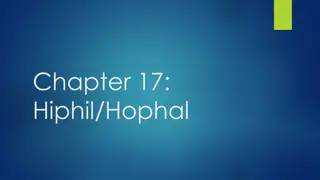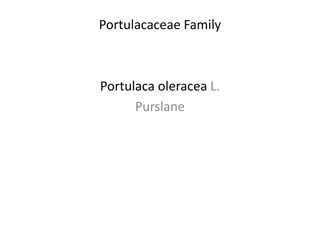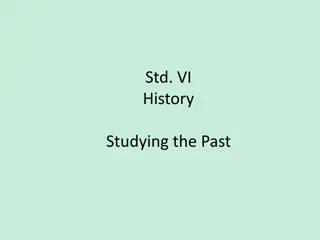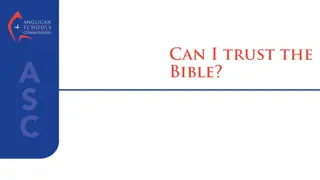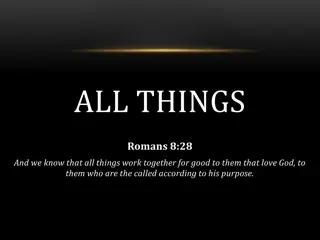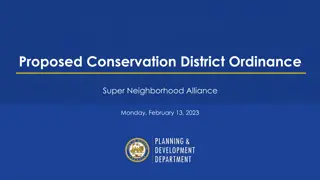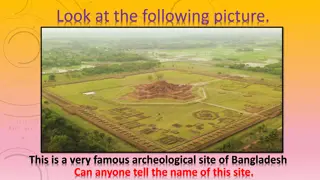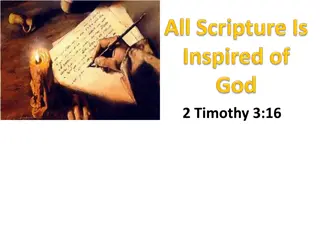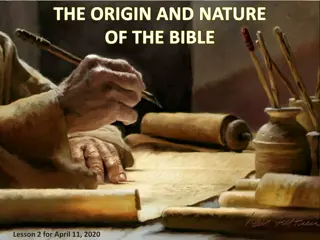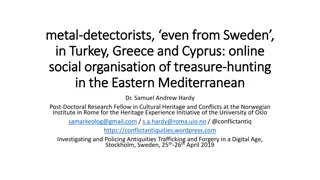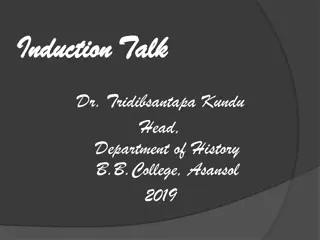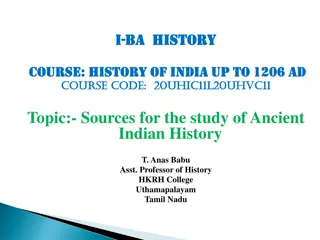Understanding the Historical and Archaeological Aspects of the Scriptures
Delve into the reliability of the Scriptures through a historical and archaeological survey. Explore the origins of the Bible, the concept of the Holy Scriptures, the Canon formation, and the structure of the Hebrew Bible and its various sections like the Torah, Prophets, and Writings.
Download Presentation

Please find below an Image/Link to download the presentation.
The content on the website is provided AS IS for your information and personal use only. It may not be sold, licensed, or shared on other websites without obtaining consent from the author. Download presentation by click this link. If you encounter any issues during the download, it is possible that the publisher has removed the file from their server.
E N D
Presentation Transcript
The Reliability of the Scriptures: A Historical and Archeological Survey 1
THE BIBLE LECTURE 8 2
THE CANON OF THE BIBLE The final question is, what is the Bible and how we got it? The word Bible itself is simply a transliteration of the Greek word b blos ( ), meaning "book." So, the Bible is, quite simply, THE BOOK. The issue is who made them into a collection, not their origin or content The word "canon" is of Christian origin, from the Gk. kan n,,which is derived from a Semitic root qan , Hebrew q neh Literary means rod or measuring stick, later it meant a rule or norm of faith, and eventually, a catalogue or list. In present usage it signifies a collection of religious writings divinely inspired and hence authoritative, normative, sacred, and binding.
The concept of Holy Scriptures Scripture in the technical sense of a standard collection or body of sacred writings by the church fathers of the 2nd, 3rd, 4th centuries: The 59th canon of the Council of Laodicea ( A.D. 363) In the Festal Epistle of Athanasius (367), and by Amphilochius, archbishop of Iconium (395). The Hebrews called the collection of holy writings, the Scriptures The Talmud calls the Scriptures defile hands, as a warning that no unclean hands can touch the sacred texts
THE TRI THE TRI- - PARTITE PARTITE HEBREW BIBLE, HEBREW BIBLE, THE THE TANACH TANACH (1) the T R H, or the Law (2) The NEVI IM or the Prophets (3) KETUVIM, the Writings
THE TORAH or PENTATEUCH GENESIS, B rishit In the beginning EXODUS, Shemot these are the names LEVITICUS, Wayiqra the Lord called Moses NUMBERS, B midbar in the wilderness DEUTERONOMY, Devarim, the words Law or Instruction
JOSHUA JUDGES I SAMUEL II SAMUEL THE PROPHETS THE PROPHETS I KINGS II KINGS ISAIAH JEREMIAH EZEKIEL
HOSEA JOEL AMOS OBADIAH JONAH MICAH NAHUM ZEPHANIAH HABAKKUK HAGGAI ZECHARIAH MALACHIAH THE TWELVE THE TWELVE MINOR MINOR PROPHETS PROPHETS
PSALMS PROVERBS JOB THE SONG OF SONGS RUTH LAMENTATIONS ECCLESIASTES ESTHER DANIEL EZRA NEHEMIAH I CHRONICLES II CHRONICLES THE WRITINGS THE WRITINGS
EXAMINATION OF THE WITNESSES The Old Testament witness to Itself Samaritan Pentateuch (432 BC) The Septuagint (285-247 BC) Jesus ben Sirach or Ecclesiasticus (180 BC) 1 and 2 Maccabees (134 and 70 BC) Philo of Alexandria (20 BC 50 AD) The New Testament (56 90 AD) Josephus (37 100 AD) Councils of Jamnia (90 and 118 AD) The Talmud (200 500 AD)
Peshitta or Syriac version (150 AD) Justin Martyr (164 AD) OLD TESTAMENT IN THE EASTERN CHRISTIAN CHURCH Melito, bishop of Sardis (170 AD) Origen of Alexandria (d. 254) Canon of Laodicea (ca 363) Anastasios, patriarch of Antioch (500 AD) Leontius of Byzantium (580 AD)
The Church Fathers (120300) Tertullian of Carthage (150-230) OLD TESTAMENT IN THE WESTERN CHURCH Jerome and the Latin Vulgate(342-420) Agustin and the 3 Councils (393, 397 and 419)
CANON OF THE NEW TESTAMENT Why did just these twenty-seven books, out of a very extensive body of early Christian writings, come to be received as divinely authoritative? The first official recognition of the twenty-seven books of the present NT canon as being the NT canon of the Church did not occur until A.D. 367 What were the sources for accepting these 27 books as part of the Holy Scriptures and adding them to the Old Testament? The early church understood that the Old Testament was fulfilled by Jesus The ultimate authority for the primitive Church was the living authority of the risen Lord Himself. The Apostles
THE FOUR STAGES IN THE DEVELOPMENT OF THE NEW TESTAMENT IN THE EARLY CHURCH The First Stage starts on Pentecost in the Jerusalem church, to AD 140 The letters of Paul were the first documents to be collected Early history of the Four Gospels To fulfill the great commission to preach, teach, and make disciples, required the knowledge of what Jesus said and did. Many heretical gospels arose within the Church, but they never occupied a place alongside the canonical four.
Marcion of Sinope--The work of Marcion, (AD 154) though heretical, is important because it represents a direct, unique attempt by an individual to establish a Christian canon. The threat of Gnosticism and Montanus starting in the 2nd century sped up the need to fix the canon Justin Martyr in Apologyand Dialogue with Trypho (150 and 160) says that the Church in its Sunday worship reads "the memoirs of the apostles or the prophetic writings" (Apol. i.67 .3). And these "memoirs" are the "Gospels" (Dial. 66 .3), the first instance in which the term "Gospel" clearly designates a book. Melito of Sardis (180) speaks of the Old Covenant and the New Covenant The Scillitan Martyrs (180) were treasuring the books and the Epistles of Paul, a just man From A.D. 140 to 180 THE SECOND PERIOD IN THE DEVELOPMENT OF THE CANON
THIRD STAGE 180 A.D. AND AFTER Irenaeus in Against Heresies cites 27 writings as canonical (AD 185) The MURATORIAN FRAGMENT is perhaps the oldest known list of most of the books of the New Testament. A Latin translation of the 7th century from an original Greek manuscript about 170 AD Tertullian of Carthage (155-220 AD) divides the 27 books of the New Testament as evangelical and apostolic Clement of Alexandria and Origen (185-255) knew and used all the 27 books of the New Testament and divided them into (a) undisputed texts, (b) disputed, and (c) heretical Eusebius Ecclesiastical History (260-339) Acknowledged : the Four Gospels, 13 Pauline letters, 1 Peter, 1 John, Acts and Revelation. Disputed : 2 Peter, 2 and 3 John, Hebrews, James, and Jude. False all the heretical gospels, heretical Acts, and Apocalypses.
Biblical apocrypha are a set of texts included in the Septuagint and the Latin Vulgate, but not in the Hebrew Bible. Apocrypha, While Catholic tradition considers some of these texts to be deuterocanonical, and the Orthodox Churches consider them all to be canonical, Protestants consider them apocryphal, that is, non- canonical books that are useful for instruction. Luther's Bible placed them in a separate section in between the Old Testament and New Testament called the Apocrypha, a convention followed by subsequent Protestant Bibles. Other non-canonical apocryphal texts are generally called pseudepigrapha, a term that means "false attribution Deuterocanonical, and Pseudepigraphal Books
Tobit Judith Baruch Sirach 1 Maccabees 2 Maccabees Wisdom Additions to Esther, Daniel, and Baruch List of Deuterocanonical Books
CONCLUSION There is ample evidence for the reliability of the Holy Scriptures that make up the Bible. Archaeology has provided circumstantial evidence of facts, people, and places mentioned in the Old Testament There is historical and archaeological evidence that supports the reliability of the transmission of the New Testament Manuscripts The Bible was written by dozens of individual over a period of more than 1,000 years, in three different languages. Nevertheless, it is and contains the gradual history of God s revelation to humankind. History has given to the Bible a unique place in world literature Most importantly, it continues to bring God s word to every person
All Scripture is God-breathed and is useful for teaching, rebuking, correcting and training in righteousness, so that the man (and woman) of God may be thoroughly equipped for every good work. 2 Timothy 3:16-17 WHAT DOES THE BIBLE DO FOR ME? WHAT DOES GOD WANT ME TO DO WITH THE BIBLE?


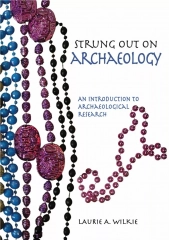
![READ⚡[PDF]✔ European Mail Armour: Ringed Battle Shirts from the Iron Age, Roman](/thumb/20552/read-pdf-european-mail-armour-ringed-battle-shirts-from-the-iron-age-roman.jpg)

